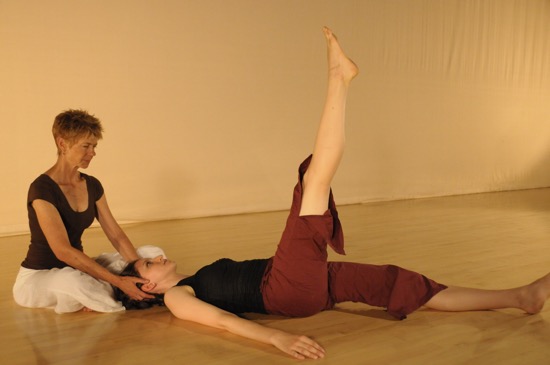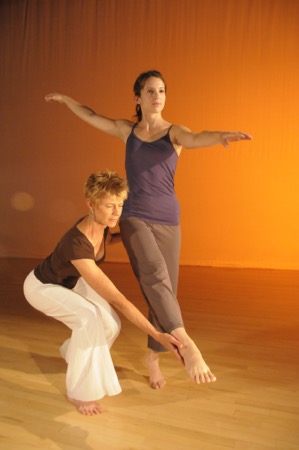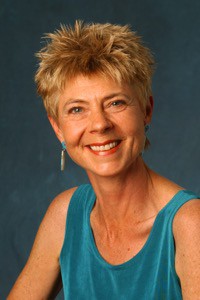
I’m very pleased to bring you this current article, on The Alexander Technique, from a longtime dance / dance medicine colleague of mine, Nada Diachenko, faculty in the Dept. of Theatre and Dance at University of Colorado, Boulder.
Nada was a professional dancer in New York for many years, primarily with Erick Hawkins, before she went into the academic dance world. We first met at the American Dance Festival (Durham, NC) 30+ years ago, and formed a lasting professional and personal friendship based on our mutual interest in dancers’ well-being and health. Over the years we have had many opportunities to work together at CU-Boulder, teaching Dance Wellness course offerings and starting a Dance Wellness Screening Program, along with Pilates.
Nada’s particular focus for many years has been The Alexander Technique (AT) – teaching dancers how this particular neuromuscular re-education practice can help facilitate more comfortable and productive movement in their bodies, both in dance and daily life. I have experienced AT many times over the years, both with Nada and other practitioners, and always strive to incorporate many of the principles daily, to allow more ease in my body movements. I’m so pleased that she offered to write this article for us.
Nada has included some excellent links for further reading / researching on AT – enjoy and pass it on!
– Jan Dunn, MS, Dance Wellness Editor
by Nada Diachenko
Do you ever wonder why you get the same correction year after year?
Or why you continue to work on your turns and they don’t get better?
And maybe you struggle with learning a new style and can’t figure out how to make that easier.
Personal History
Honestly, if I had asked myself those questions as a young dancer I would have had to answer yes. In retrospect, I wish I had studied the Alexander Technique (AT) at 19 when I first discovered an AT book at a NYC bookstore. That book sat on my shelf for years. When I finally had a series of weekly lessons, I discovered ease, freedom of movement, balance, and an overall sense of organization. Then I read that book, Body Learning, by Michael Gelb which led me on a life changing journey as a dancer and teacher.
It wasn’t until I moved to Colorado after a 20 year career in NYC as a professional dancer that I began to understand the power of the technique.
While on faculty at the University of Colorado (CU), I realized I wanted to help dancers go deeper in changing inefficient movement habits. It also became clear to me that I needed AT for myself in order to continue to move and dance into the future with less strain and pain.
So I trained and became a certified AT teacher. I learned skills and gained tools that helped me change some of my very strong compensation patterns from injuries and imbalances from my scoliosis. Incorporating these skills and tools that helped me so much, I developed AT courses for undergraduate and graduate students at CU. One of their basic requirements is to read Body Learning.

What is the Alexander Technique?
The Alexander Technique is a somatic (mind-body) method that will help you recognize habits that interfere with ease of movement and balanced alignment. Often we aren’t even aware of these automatic responses that could be the cause of excess tension, stress, faulty technique, and performance anxiety.
When we change our thinking and can stop ourselves from immediately doing the movement the same way with the same old habits, we can then improve how we do what we do. It teaches us how to peel away and free ourselves from the layers of patterns that interfere with our natural organization (balanced physical, emotional, and mental functioning).
Who Was Alexander
F.M. Alexander (1869-1955) was an actor who discovered that his habit of tightening his neck and pulling his head back and down caused him to lose his voice in performance as well as causing other problems in his spine. It took him 9 years studying himself in mirrors to figure out what he was doing wrong and to find a new way to bring about a change.
What made this so difficult was that his habits felt normal and that when he was more balanced and not doing the inefficient pattern it felt wrong. He found this to be true for everyone he taught when trying to change.
Mr. Alexander spent his life developing a method and training teachers to help others recognize poor habits and to learn skills to improve how we function as a whole – mind, body, and emotions. He taught that there is no mind-body split – everything we do engages all aspects of ourselves.
He discovered that the balanced relationship between the head, neck, and back was a key factor in how the body moves and in finding a balanced alignment. Alexander teachers help their students find this primary organization and learn ways to think about finding this balance on their own.
Experiential Activities
Here are some useful guidelines in exploring some of the principles of AT without a teacher. You can begin by observing how you do simple dance and daily movement. Begin to develop a greater awareness of yourself.
So the first step is to observe yourself!
Pay attention to what is happening as you prepare to do a dance exercise.
Do you tighten your neck?
Does your head push forward or back in preparation for moving?
Perhaps you clench your jaw, hold your breath, thrust your ribs forward or tense somewhere in the body where it isn’t needed.
- Notice what you do.
- Get a friend to video you.
We can’t change a poor habit if we aren’t aware of it. Most of the time we just do and don’t think about how we want to do the action.
Notice if you have some of the same habits or reactions in daily life.
Give special attention to the head and neck.
Observe yourself, eating, texting, sitting at the computer, walking (also with a backpack), going from sitting to standing and lying down, going up and down stairs, picking up something, brushing your teeth, etc.
Do the same activities with the thought of letting your neck be easy and free
What do you notice?
Dance Experiment
 Next time you are in class notice if you have a habit of getting ready by using extra tension just prior to doing plies or any movement.
Next time you are in class notice if you have a habit of getting ready by using extra tension just prior to doing plies or any movement.
Then pause and decide that you don’t need that extra tension and choose to do it with less effort. This will help you to not immediately do the action in the old way and help you stay in the present instead of thinking only of the final result.
The stopping or pausing allows your thought of what you don’t want to influence the nervous system and slow down the impulses to the muscles. With less shortening/contracting, the muscles can come into more length, creating greater length and ease. (AT principle of inhibition)
Benefits for dancers learning AT:
- Better understanding of how the body works as a whole rather than lots of separate parts
- Understanding of the value of focus on the process and not just the end result (the way to find the higher leg or bigger jump rather than just forcing it to happen)
- Ability to use the appropriate amount of tension
- Quicker facilitation of technique modifications
- Improved breathing coordination
- Better mind-body communication
- Increased awareness of how you are actually doing what you think you are doing
- Increased ability to make choices – not being a slave to the habit
- Improved responses to all types of stressors in daily and dance life (calmer nervous system)
For More Information About AT:
- Get a lesson from a certified AT teacher.
- Go to AmSATonline.org to find a teacher in your area or a teacher training course where advanced trainees need practice students.
- To learn about research on AT check the following links:
http://www.amsatonline.org/research
List of selected research studies involving AT that have been published in peer review scientific journals or presented at conferences
http://www.alexanderstudies.org/news/promising-results-knee-osteoarthritis-study
Most recent study, 2016 on knee pain
http://www.bmj.com/content/337/bmj.a884.full
AT benefit for chronic and recurrent back pain
Study from the British Medical Journal 2008
For further reading:
What Every Dancer Needs to Know, Robin Gilmore
Dance and the Alexander Technique: Exploring the Missing Link, Luc Vanier and Rebecca Nettle-Fiol
How To Learn the Alexander Technique, Barbara Conable

Nada Diachenko has worked in the professional and academic dance field during her 50 year career as a dancer, choreographer, educator, and somatic specialist.
She is a certified Alexander Technique Teacher (1999), certified in Jessica Wolf’s, The Art of Breathing (2014), and a Muscular Therapist in the Benjamin System of Muscular Therapy (1984 certified) who has worked extensively with dancers as well with actors, musicians, and singers. Nada has also intensively studied and practiced Ideokinesis, Pilates, Kinetic Awareness with Elaine Summers, Body Mind Centering, Franklin Method, Feldenkrais, Trager Method, and most recently Gyrotonics.
She is on the faculty of Alexander Technique Denver teaching training program (AT Den), and teaches privately in Boulder, Co. Nada is also a full professor in the Department of Theatre and Dance at the University of Colorado, Boulder where she teaches Alexander courses and directs the MFA Somatic Track and the Wellness Program. She combines teaching, choreographic projects, somatic studies, and continues her research in integrating AT in dance training.
Prior to joining the faculty at CU, she spent 20 years in NYC as a soloist and master teacher with the Erick Hawkins Dance Company, co-artistic director/choreographer/dancer with the NYC based Greenhouse Dance Ensemble, and artistic director of Nada Diachenko and Dancers and Nada Diachenko: Solo Dance. While in NYC, she taught at New York University as an adjunct Assistant Professor of Dance for 10 years.
She has choreographed, guest taught, performed, and conducted workshops at numerous colleges and dance festivals nationally and internationally. She has conducted workshops in the Alexander Technique, dance, and injury prevention throughout the USA, Central and South America, and Europe. Nada has been a presenter for the annual American Society for the Alexander Technique Conference and the Freedom to Move Conference in NYC. For more information, visit her website at www.nadadiachenko.com




